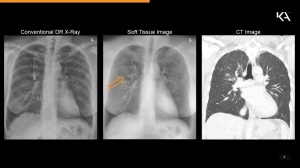by
John R. Fischer, Senior Reporter | April 22, 2022

KA Imaging will develop the world's first dual-energy mobile X-ray system using its 35C Reveal detector.
KA Imaging in Canada is putting up nearly $1.5 million for the creation of the world’s first dual-energy mobile X-ray system.
The solution will be equipped with the company’s Reveal 35C dual-energy X-ray detector, a portable detector that utilizes dual energy to create three images in a single exposure: a standard chest X-ray, a soft tissue image without bone, and a bone image without soft tissue. It will be the first made-in-Ontario mobile X-ray scanner, with the company investing $1,488,000.
KA Imaging specializes in the development of X-ray imaging technologies and systems and has 80 global patents. Its use of dual-energy eliminates motion artifacts and captures images in which the bone and soft tissue do not overlap one another, at the same dose as a standard chest X-ray. With these separate images, radiologists can better assess the lungs and soft tissue without bones obstructing their view and vice-versa, and can locate lesions or signs of a disease more easily. Because it is portable and retrofittable, it can be used with any existing X-ray system, including point-of-care units at the patient’s bedside.
The addition of dual-energy capabilities is expected to increase the system’s diagnostic capacity and make it helpful for assessing critical care patients and those in rural and remote communities where access to X-ray machines, CT scanners and MRs is limited.
“Something that shows up in the bone image most likely is calcified, like a calcified nodule, a calcified artery, a calcified vessel; and something that shows up in the soft tissue is soft tissue. In regular X-ray, you have to guess if a nodule is calcified or not. By material discrimination, you add an additional layer of analysis and data for the clinician, and it allows the clinician to make a better decision than they would if they were just looking at regular X-ray imaging, mobile or fixed," Dr. Karim Karim, founder and CTO of KA Imaging, told HCB News.
Fixed dual-energy imaging must be used on ambulatory patients, or the patient has to be able to go for imaging. If a patient cannot be moved to the X-ray room and there is no alternative, they must undergo CT, which exposes them to 50 times more radiation. And in rural and remote areas, CT may not even be available.
Among the potential areas where Reveal 35C could be used are the ICU, neonatal and pediatric wards, long-term care facilities and prisons, especially for any patients who are bedridden and cannot be moved. "The advantage of having dual energy or spectral imaging in the mobile for the first time is that you're going to get better clinical outcomes. With better differentiation than a regular X-ray, and without extra radiation dose, without the fixed infrastructure and without the high cost," said Karim.
KA Imaging recently
showcased it at RSNA 2021, along with the findings of a study which showed that the solution helped radiologists identify 25% more cases of pneumonia, including COVID-19, than a standard X-ray in immunocompromised cancer patients.
Helping to fund the mobile X-ray project is the Ontario Together Fund, which will put forth $967,200. Four new jobs will also be created. “Through the Ontario Together Fund, our government is making strategic investments in innovative homegrown businesses with the ideas and solutions to help us support Ontario’s vibrant innovation and Medtech ecosystem,” said Vic Fedeli, minister of economic development, job creation and trade, in a statement.
